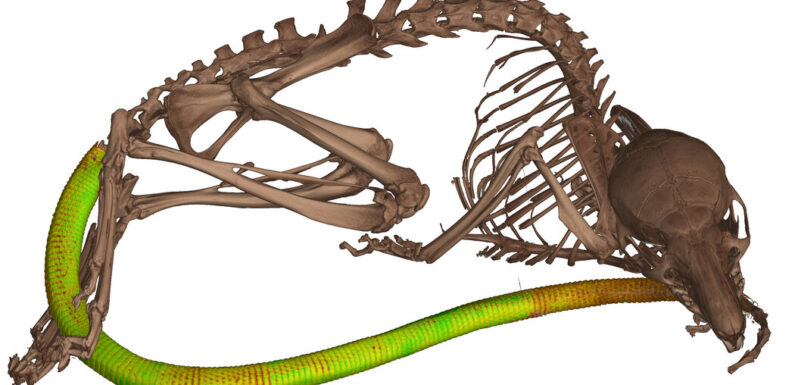
At first it looks like a slightly more hairy rodent. But the spiny mouse’s body is full of secrets. Found in rock outcrops throughout Africa and Europe, its back is full of porcupine-like quills made of stiffened fur. It has soft, easily torn skin and a remarkable ability to regenerate, like a species of desert gecko. Now, researchers have revealed another surprise in the journal iScience on Wednesday: Their tails are lined with osteoderms, or bony plates, making them only the second group of living mammals known to be equipped with underskin armor like an armadillo.
“Although spiny mice are widely known and commonly used in all sorts of lab experiments, nobody had ever noticed they had these,” said Edward Stanley, a biologist at the Florida Museum of Natural History and an author on the study.
The discovery came when he was CT scanning specimens for the openVertebrate Project, an effort to build a public online database of 20,000 vertebrate specimens from museum collections across the United States. X-rays of the mouse’s tail gave him pause: They reminded him of the lizards he had worked on for his Ph.D. But the only living mammals with known osteoderms were armadillos.
“I know enough about osteoderms that it’s a fairly unknown thing for rodents to have them,” Dr. Stanley said.
The discovery was serendipitous, said Malcolm Maden, a biologist with the University of Florida and an author on the study. Dr. Maden already had a longstanding research project built around spiny mice, centered around their remarkable ability to regenerate skin, muscle, nerves and parts of their spinal cord. The researchers joined forces, studying how the osteoderms developed over a mouse’s life span and sequencing the species’ RNA in an attempt to identify the genetic switches responsible for the bone armor’s development.
Dr. Stanley also scanned specimens of the spiny mouse’s closest relatives — the link rat, brush-furred mouse and Rudd’s mouse. He found that all three also had armored tails, while more distant relatives did not. The discovery suggested that a common ancestor of all four species possessed the trait.
The purpose of the osteoderms isn’t clear. Spiny mice may use them to shield themselves from predators while burrowed in crevices, Dr. Stanley said. Another possibility: While the mice’s skin tears easily, the armor might help protect the inner tail structure, like wearing chain mail under an easily-removed glove.
Osteoderms have re-evolved at least 19 times in different lineages of animals, Dr. Maden said. They are often found in reptiles such as lizards, crocodiles and nonbird dinosaurs. They have also been found in a few extinct mammal groups, like immense armadillo relatives called glyptodons and giant ground sloths — whose skin armor the spiny mouse’s closely resembles.
Finding osteoderms in a fast-breeding, easily maintained animal like a mouse could help unlock how and why the forces of evolution have continually produced underskin bone armor, Dr. Maden said. Now that they have narrowed down a list of genes that might be responsible for this trait, they can try to produce osteoderms in lab studies.
“I want to work out what genes are responsible for making osteoderms and then make a lab mouse with armor plating,” Dr. Maden said.
The building blocks for osteoderms might be in the heads of vertebrates, Dr. Stanley said. The vertebrate skeleton is largely formed of cartilage that grows bonier over time — but the skull bones form through hardening collagen, which the team suggests might have been repurposed from the armored heads in early lineages of fish.
“If you can grow a skull, you have the genetic architecture to grow bones in your skin,” Dr. Stanley said. The trick will be to use genomics to figure out whether the mice’s tail osteoderms form like their skulls. “That would lend credence to the idea that osteoderms went from armor, to skulls, back to armor.”
It’s also possible that osteoderms, which are generally tucked discreetly under fur and skin, may be considerably more common in mammals than generally thought: Nobody has actively gone looking for them, Dr. Stanley said. It took exploratory science like the openVertebrate Project to find them, he noted. Dr. Stanley hopes data from the project will lead to similar discoveries.
“Building that kind of accessibility to museum samples and the digital data pulled from them will have benefits for all kinds of fields,” Dr. Stanley said. “After all, we didn’t know what we were about to find.”
Source: Read Full Article